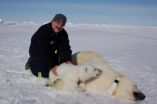Smoking may worsen pain for cancer patients
According to new study published in Pain
2010-12-22
(Press-News.org) Philadelphia, PA, December 21, 2010 – The relationship between smoking and cancer is well established. In a study published in the January 2011 issue of Pain, researchers report evidence to suggest that cancer patients who continue to smoke despite their diagnosis experience greater pain than nonsmokers. They found that for a wide range of cancer types and for cancers in stages I to IV, smoking was associated with increased pain severity and the extent to which pain interfered with a patient's daily routine.
"To elucidate important relations between pain and smoking among persons with cancer, and to identify prospective targets for intervention, it is necessary to build upon past findings by examining smoking status and pain reporting in greater detail, across a wider range of cancer patients, and with regard to potential benefits of quitting smoking," commented lead investigator Joseph W. Ditre, PhD, Department of Psychology, Texas A&M University. "Specifically, we hypothesized that, among patients with diverse cancer diagnoses, current smokers would report greater pain, pain interference, and pain-related distress than former smokers and/or never smokers. We also planned to examine associations between pain and other smoking variables (e.g., number of years since quitting) in an exploratory fashion."
In this cross-sectional study, investigators surveyed 224 patients with a range of cancer diagnoses. Patients completed self-report measures of pain severity, pain-related distress, and pain-related interference, as well as a demographics questionnaire. Patients were asked to rate their perceived severity of bodily pain (1 = ''none" to 6 = ''very severe") and the degree to which pain interfered with their daily routine (1 = ''not at all" to 5 = ''extremely"). Current smokers experienced more severe pain than never smokers, and also reported more interference from pain than either never smokers or former smokers. Among former smokers, there was an inverse relation between pain and the number of years since quitting, suggesting that quitting smoking may reduce pain over time.
"Clinicians must do more to assist cancer patients to quit smoking after their diagnosis," according to Lori Bastian, MD, Durham VA Medical Center and Department of Internal Medicine, Duke University, writing in an accompanying commentary. While pointing out the complexities inherent in studies of the relationships among pain, cancer diagnoses, and nicotine addiction, she observed that "The major strength of this study is the diverse types of cancer and stage of disease." She continues, "Although more research is needed to understand the mechanisms that relate nicotine to pain, physicians should aggressively promote smoking cessation among cancer patients. Preliminary findings suggest that smoking cessation will improve the overall treatment response and quality of life."
INFORMATION:
The article is "Associations between pain and current smoking status among cancer patients" by Joseph W. Ditre, Brian D. Gonzalez, Vani N. Simmons, Leigh Anne Faul, Thomas H. Brandon, and Paul B. Jacobsen (DOI: 10.1016/j.pain.2010.09.001). The accompanying commentary is "Pain and smoking among cancer patients: The relationship is complex but the clinical implication is clear" by Lori Bastian (DOI: 10.1016/j.pain.2010.10.023). Both the article and its commentary appear in Pain, Volume 152, Issue 1 (January 2011) published by Elsevier.
END
ELSE PRESS RELEASES FROM THIS DATE:
2010-12-22
VIDEO:
Western Ph.D. student Jessica Metcalfe discusses the reasons why woolly mammoths roaming the Yukon Territories thousands of years ago waited so long to eat plants and how she and her...
Click here for more information.
New research from The University of Western Ontario leads investigators to believe that woolly mammoths living north of the Arctic Circle during the Pleistocene Epoch (approx. 150,000 to 40,000 years ago) began weaning infants up to three years later than ...
2010-12-22
Salt Lake City, Dec.21, 2010—The vast majority of parents who tested positive for a genetic mutation that increases the risk of melanoma (the most serious form of skin cancer) support genetic testing of their children or grandchildren. Results of the two-year study at Huntsman Cancer Institute (HCI) at the University of Utah (U of U) appear in the December issue of the journal Genetics in Medicine. The data could lead to the establishment of formal, evidence-based guidelines for genetic testing of people younger than 18 years.
The study, led by Sancy A. Leachman, M.D., ...
2010-12-22
Research on reducing risks, improving medical treatment and improving lifestyle behaviors to fight the battle against heart disease and stroke are among the key scientific findings that make up this year's top cardiovascular and stroke research recognized by the American Heart Association/American Stroke Association.
The association has been compiling an annual list of the top 10 major advances in heart disease and stroke research since 1996. This year, for the first time, two separate lists have been compiled that highlight the top ten research advances in each respective ...
2010-12-22
ANN ARBOR, Mich.---New observations by University of Michigan astronomers add weight to the theory that the most massive stars in the universe could form essentially anywhere, including in near isolation; they don't need a large stellar cluster nursery.
This is the most detailed observational study to date of massive stars that appear (from the ground) to be alone. The scientists used the Hubble Space Telescope to zoom in on eight of these giants, which range from 20 to 150 times as massive as the Sun. The stars they looked at are in the Small Magellanic Cloud, a dwarf ...
2010-12-22
New Rochelle, NY, December 21, 2010—A festschrift honoring Daniel H. Lowenstein, a pioneering legal scholar, Professor at UCLA School of Law, and Founding Co-Editor of Election Law Journal, who devoted his career to advancing election law and campaign finance reform, highlights the current issue of Election Law Journal, a peer-reviewed publication of Mary Ann Liebert, Inc. The issue is available free online.
"Dan quite literally founded the field of election law," says UCLA School of Law professor and colleague of Lowenstein's, Adam Winkler in his introduction. Winkler ...
2010-12-22
New Rochelle, NY, December 21, 2010—Pregnancy among women veterans who served in Iraq and Afghanistan appears to increase their risk for mental health problems such as depression, anxiety, and post-traumatic stress disorder (PTSD), according to a study published in Journal of Women's Health, a peer-reviewed journal published by Mary Ann Liebert, Inc. The paper is available free online.
The stress associated with military service in a war zone may later contribute to an increased risk of mental health problems if a woman veteran becomes pregnant. Because the hormonal ...
2010-12-22
Every hour, an enormous quantity and variety of manmade chemicals, having reached the end of their useful lifespan, flood into wastewater treatment plants. These large-scale processing facilities, however, are designed only to remove nutrients, turbidity and oxygen-depleting human waste, and not the multitude of chemicals put to residential, institutional, commercial and industrial use. So what happens to these chemicals, some of which may be toxic to humans and the environment? Do they get destroyed during wastewater treatment or do they wind up in the environment with ...
2010-12-22
Cold Spring Harbor, NY-- Newly published research led by Professor Z. Josh Huang, Ph.D., of Cold Spring Harbor Laboratory (CSHL) sheds important new light on how neurons in the developing brain make connections with one another. This activity, called synapse validation, is at the heart of the process by which neural circuits self-assemble, and is directly implicated in pathology that gives rise to devastating neurodevelopmental disorders including autism and schizophrenia.
In the mammalian brain, even in its early stages of postnatal development, the cortex, the seat ...
2010-12-22
BUFFALO, N.Y. -- Moderately and morbidly obese persons face many health issues -- heart disease, diabetes, hypertension, stroke, gallbladder disease and others.
Now, increased chances of dying while driving during a severe auto accident can be added to the list.
In a severe motor vehicle crash, a moderately obese driver faces a 21 percent increased risk of death, while the morbidly obese face a 56 percent increased risk of not surviving, according to a study posted online ahead of print in the American Journal of Emergency Medicine.
Dietrich Jehle, MD, professor of ...
2010-12-22
VIDEO:
Science team placing radio collars on polar bears.
Click here for more information.
PORTLAND, Ore. December 21, 2010. "When I first picked up the cub, she was biting my hand," explains wildlife biologist Bruce Marcot. He was trying to calm the squirming cub while its sedated mother slept nearby.
In the snowy spring of 2009, Portland-based Marcot traveled with several colleagues onto the frozen Arctic Ocean north of Alaska to study and survey polar bear populations. ...
LAST 30 PRESS RELEASES:
[Press-News.org] Smoking may worsen pain for cancer patients
According to new study published in Pain



